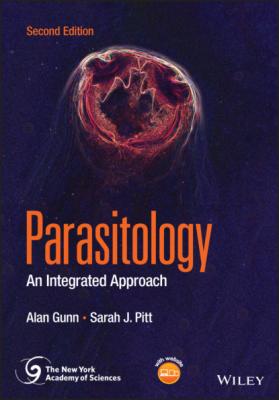Parasitology. Alan Gunn
Чтение книги онлайн.
Читать онлайн книгу Parasitology - Alan Gunn страница 45
 rel="nofollow" href="#fb3_img_img_b4622cc4-6ad5-554f-8ad1-7d63ad1b0785.jpg" alt="Schematic illustration of diagram of a typical trypanosome."/>
rel="nofollow" href="#fb3_img_img_b4622cc4-6ad5-554f-8ad1-7d63ad1b0785.jpg" alt="Schematic illustration of diagram of a typical trypanosome."/>
Figure 4.1 Diagram of a typical trypanosome. Kp: kinetoplast; Ks: kinetosome; F: flagellum; Mit: mitochondrion; Gly: glycosome; N: nucleus; Lys: lysosome; Um: undulating membrane.
Figure 4.2 Morphological forms of trypanosomes. (a) Trypomastigote. (b) Epimastigote. (c) Promastigote. (d) Amastigote. The flagellum pulls the cell forwards rather than pushes it from behind. Arrows: direction of movement.
The Kinetoplastida have a unique organelle called the glycosome. This may be related to the peroxisomes (which they do not have) found in other organisms. The glycosomes are about 0.25 μm in diameter and contain glycolytic enzymes that are normally present in the cytoplasm of other organisms. The bloodstream forms of trypanosomes are extremely metabolically active and soon die if they run out of glucose to metabolise. The glycosomes are the site of glucose metabolism, and therefore, like the kinetoplast DNA, they are a potential target for antiparasitic drug design.
Many species within the Kinetoplastida are only parasitic in insects. For example, members of the genus Leptomonas live in the gut of various insects including blood‐feeding reduviid bugs (Kaufer et al. 2017). Because they have only a single host, these species are referred to as monoxenous although there are rare case reports of human infections in patients who are HIV+ve. There are also accounts of Leptomonas co‐infections with visceral leishmaniasis and post kala‐azar dermal leishmaniasis caused by Leishmania donovani (Thakur et al. 2020).
Many of the Kinetoplastida alternate between an invertebrate host such as a blood‐feeding insect or leech, and a vertebrate host with development occurring in both. Parasites that have more than one type of host are called heteroxenous. Heteroxenous Kinetoplastida species often express two or more morphological forms with one form present in the invertebrate and the other in the vertebrate (Table 4.2). Some members of the Kinetoplastida exhibit sexual reproduction, or something similar (Berry et al. 2019; Gibson and Peacock 2019), but it is uncertain whether it is a widespread phenomenon in the group.
4.2.1 Genus Leishmania
Members of the genus Leishmania exhibit two distinct morphologies: the amastigote form that occurs in the vertebrate host, and the promastigote form that occurs in the invertebrate vector. The vertebrate hosts are mostly mammals, whilst the invertebrates are various species of sandflies. Those species parasitic in reptiles belong to the subgenus Sauroleishmania and do not cause zoonotic infections. Perhaps counter‐intuitively, molecular evidence indicates that the Leishmania evolved in the Neotropical regions during the Mesozoic era as parasites of mammals and those species parasitizing reptiles, the Sauroleishmania, subsequently evolved from them (Noyes et al. 2000).
Table 4.2 Morphological forms of Kinetoplastida parasitic in humans and domestic animals.
| Morphological form | Description | Example |
|---|---|---|
| Amastigote | Kinetoplast and kinetosome above the nucleus, flagellum short and confined in pocket. Cell shape globular | Leishmania donovani inside vertebrate macrophage Trypanosoma cruzi in human spleen, liver, muscle, and other cell types |
| Promastigote | Kinetoplast and kinetosome at anterior end of cell, flagellum free, and long. Cell shape elongate | Leishmania donovani in sandfly gut |
| Epimastigote | Kinetoplast and kinetosome close and anterior to the nucleus. There is a short undulating membrane before the flagellum emerges at the anterior of the cell. Cell shape elongate | Trypanosoma cruzi in triatomid gut |
| Trypomastigote | Kinetoplast and kinetosome at posterior end of cell. Flagellum forms an undulating membrane that runs the length of the cell and may continue free when it reaches the anterior end. Cell shape elongate | Trypansoma cruzi in human bloodstream |
Trypanosomes that are parasitic insects exhibit other morphological forms, such as choanomastigote, opisthomastigote, and paramastigote.
Table 4.3 Taxonomic divisions within the genus Leishmania.
| Genus | Subgenus | Disease | Example |
|---|---|---|---|
| Leishmania | Leishmania | Visceral | Leishmania donovani phenetic complex Leishmania infantum phenetic complex |
| Old World cutaneous | Leishmania major phenetic complex Leishmania tropica phenetic complex | ||
| New World cutaneous | Leishmania mexicana phenetic complex | ||
| Viannia | New World | Leishmania braziliensis phenetic complex | |
| Sauroleishmania | Lizard leishmaniasis | Leishmania tarentolae |
The taxonomy of the genus Leishmania is complex, and it is extremely difficult or impossible to distinguish many of them from their morphology using a light microscope. Lainson and Shaw (1987) comprehensively reviewed the genus and molecular and phylogenetic studies have largely supported their proposals for how it should be divided (Table 4.3). However, agreement concerning the status of several species is far from complete, and there remain uncertainties about many aspects of the evolution of the Leishmania – see Schönian et al. (2018) for further details. Lainson and Shaw (1987) identified two subgenera: Leishmania and Viannia. In the subgenus Leishmania, the parasites begin their development in the sandfly vector’s midgut and then move forward to the pharynx. The sandfly then injects the parasites into the vertebrate host when she feeds. By contrast, in the subgenus Viannia the parasites begin development in the vector’s hindgut and then move forward to the pharynx.
Those species within the subgenus Viannia (e.g., Leishmania braziliensis, Leishmania peruviana, Leishmania guyanensis, Leishmania panamensis) are restricted to South America and are primarily responsible for cutaneous disease. Species belonging to the subgenus Leishmania (e.g., Leishmania donovani, Leishmania major, Leishmania infantum, Leishmania tropica, Leishmania mexicana) have representatives in both the New World and the Old World and include agents of both visceral and cutaneous disease. Because of the difficulties associated with identifying the parasites